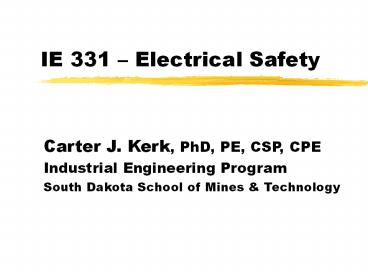IE 331 - PowerPoint PPT Presentation
Title:
IE 331
Description:
If there is more than one path, the primary flow will be through the path of least resistance ... may have a resistance of 100,000 ... Path of Least Resistance ... – PowerPoint PPT presentation
Number of Views:98
Avg rating:3.0/5.0
Title: IE 331
1
IE 331 Electrical Safety
- Carter J. Kerk, PhD, PE, CSP, CPE
- Industrial Engineering Program
- South Dakota School of Mines Technology
2
Introduction
- Read Chapter 12
- 11 of OSHA general industry citations address
electrical hazards - Improper grounding
- Ungrounded tools
- Portable tools in damp/wet locations
- Ground pin broken off
- Exposed live parts
- Sloppy electrical installations
- Breaker box open
3
Raise your hand
- Have you ever received a shock from a 110V
circuit? - Does anyone have any good stories to tell?
- Is there anyone present who has not received such
a shock?
4
Can a 110V circuit kill?
- Myth Ordinary 110V circuits are safe.
- Reality 110V circuits kill many more people
than 220 or 440V circuits (which people do
respect) - Why? Almost everyone has received a shock from a
110V circuit and lived to tell about it.
5
Useful equations
- Ohms Law
- I V / R
- Current voltage / resistance
- Watts (measure of power)
- W (V) (I)
- If there is more than one path, the primary flow
will be through the path of least resistance
6
Example
- Take a 60W bulb, I W/V 60 / 110 0.55
ampere (550 m-amps) - Dry human skin may have a resistance of 100,000
ohms - I V/R 110 / 100,000 0.0011 (about 1 m-amp)
- See Figure 12-1, hardly noticeable
- Perspiration on skin brings resistance to about
500 ohms - I V/R 110 / 500 0.22 amps (220 m-amps)
- At fibrillation threshold, possible asphyxiation
- A possible fatal dose
7
Path of Least Resistance
- If there is more than one path, the primary flow
will be through the path of least resistance - If that path leads through critical organs
(especially the heart), more likely to be fatal
8
Physiological Effects
- See Figure 12-1 and Table 12-2
- Mild shock
- Painful shock
- Muscular paralysis (no-let-go phenomenon)
- Asphyxiation
- Fibrillation (60 Hz is one of the most dangerous
frequencies for the heart) - Heart paralysis
- Tissue burning
9
Electrical Hazards
- Electric shock, heat, fire, explosion
- Electricity energizes mechanical equipment
- Some electrical devices produce harmful levels of
X rays, microwaves, laser light, magnetic fields
10
Control of Electrical Hazards
- Physical materials used, design of components,
placement of electrical equipment, shielding,
enclosures, double insulated tools - Overcurrent Devices fuses, circuit breakers
- Switching Devices lockouts, interlocks, thermal
overspeed cutouts - Grounding Bonding
- GFCI
- Low Voltage Tools
- Smart Power Integrated Circuits
- Warnings
- Procedures
11
Will a circuit breaker protect humans?
- An ordinary house circuit breaker of 20 or 30
amperes will not trip the circuit breaker until
there is a current flow of 20,000 to 30,000
m-amps, respectively - This is about 100 to 1000 time as much as the
lethal dose - This is where GFCI can save the day!!
12
GFCI
- Ground Fault Circuit Interrupter
- Protects people from electrical shock
- Very fast-acting circuit breaker that senses very
low current levels - Can sense as little as 2 mA and shut off current
in as little as 0.02 s
13
Low Voltage Tools
- Select low voltage tools for use in confined
spaces and wet areas to reduce hazard. - Operate at less than 24 V
14
First Aid
- Train personnel for special considerations for
accidents from electrical hazards - Rescuers often become victims also
- Respiratory arrest and fibrillation are common
- Knowledge of CPR is essential
- Must have immediate response
- AED Automated External Defibrillator
- See upcoming slide.
15
Test Equipment
- Two types to show
16
Static Electricity
- Sparks can ignite certain dusts and vapors
- Damage electrical equipment
17
Other Issues
- Lightning
- Battery Charging
- AED (Automatic External Defibrillators)
- One in eight workplace fatalities is due to
cardiac arrest - About half of sudden cardiac arrest victims could
be saved with CPR and defib - OSHA recommends but does not mandate
- A complete AED program includes risk assessment,
training, maintenance, and recordkeeping































